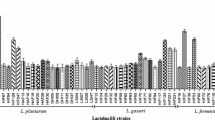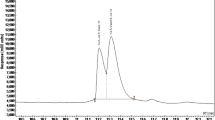Abstract
Lactobacilli isolated from the rumen of cattle were subjected to morphological and biochemical characterizations followed by PCR-based identification. Among isolates, Lactobacillus brevis was found to be the most prevalent species in the rumen. For in vitro conjugated linoleic acid (CLA) production, the two isolates of L. brevis and one each of Lactobacillus viridescens and Lactobacillus lactis were selected. The sunflower oil (i.e., 0.25, 0.5 and 1.0%; a rich source of linoleic acid) was added to skim milk as a substrate for CLA production by isolates at 37 °C/12 h. L. brevis 02 was found to be the most potential CLA producer (10.53 mg CLA/g fat) at 0.25% concentration of sunflower oil followed by L. brevis 01 (8.27 mg CLA/g fat). However, at higher level of sunflower oil (i.e., 1.0%), L. lactis was the highest CLA producer (9.22 mg/g fat) when compared to L. brevis and L. viridescens. The results indicated that L. brevis and/or CLA production was inhibited with increasing concentration of sunflower oil in skim milk. In contrast, L. lactis and L. viridescens could tolerate the increasing concentrations of sunflower oil and produced higher CLA. Overall, L. brevis extends a possibility to be used as a direct-fed microbial for ruminants to increase the CLA content in milk, however, in vivo trials are needed for validation of results obtained.
Similar content being viewed by others
References
Alonso L, Cuesta EP, Gilliland SE (2003) Production of free conjugated linoleic acid by Lactobacillus acidophilus and Lactobacillus casei of human intestinal origin. J Dairy Sci 86:1941–1946
Barrett E, Ross RP, Fitzgerald GF, Stanton C (2007) Rapid screening method for analyzing the conjugated linoleic acid production capabilities of bacterial cultures. Appl Environ Microbiol 73:2333–2337
Bligh EG, Dyer WJ (1959) A rapid method of total lipid extraction and purification. Can J Biochem Physiol 37:911–915
Boyaval P, Corre C, Dupuis C, Roussel E (1995) Effects of free fatty acids on propionic acid bacteria. Lait 75:17–29
Coakley M, Ross RP, Nordgren M, Fitzgerald G, Devery D, Stanton C (2003) Conjugated linoleic acid biosynthesis by human-derived Bifidobacterium species. J Appl Microbiol 94:138–145
Corl BA, Baumgard LH, Dwyer DA, Griinari JM, Phillips BS, Bauman DE (2001) The role of ∆9-desaturase in the production of cis-9, trans-11 CLA. J Nutr Biochem 12:622–630
Dubernet S, Desmasures N, Gueguen M (2002) A PCR based method for identification of lactobacilli at the genus level. FEMS Microbiol 214:271–275
Fukuda S, Furuya H, Suzuki Y, Asanuma N, Hino T (2005) A new strain of Butyrivibrio fibrisolvens that has high ability to isomerize linoleic acid to conjugated linoleic acid. J Gen Appl Microbiol 51:105–113
Fukuda S, Suzuki Y, Murai M, Asanuma N, Hino T (2006) Isolation of a novel strain of Butyrivibrio fibrisolvens that isomerizes linoleic acid to conjugated linoleic acid without hydrogenation, and its utilization as a probiotic for animals. J Appl Microbiol 100:787–794
Griinari JM, Bauman DE (1999) Biosynthesis of conjugated linoleic acid and its incorporation into meat and milk in ruminants. In: Yurawecz MP, Mossoba MM, Kramer JKG, Pariza MW, Nelson GJ (eds) Advances in conjugated linoleic acid research. AOCS Press, Champaign, pp 180–220
Holt JG, Kreig NR, Sneath PHA, Staley JT, Williams ST (1994) Bergey’s manual of determinative bacteriology, 9th edn. Williams and Wilkins, Baltimore
Jenkins TC, Wallace RJ, Moate PJ, Mosley EE (2008) Recent advances in biohydrogenation of unsaturated fatty acids within the rumen microbial ecosystem. J Anim Sci 86:397–412
Jiang J, Bjorck L, Fonden R (1998) Production of conjugated linoleic acid by dairy starter cultures. J Appl Microbiol 85:95–102
Kelly ML, Berry JR, Dwyer DA, Griinari JM, Chouinard PY, Van Amburgh ME, Bauman DE (1998) Dietary fatty acid sources affect conjugated linoleic acid concentrations in milk from lactating dairy cows. J Nutr 128:881–885
Kepler CR, Hirons KP, McNeill JJ, Tove SB (1966) Intermediates and products of the biohydrogenation of linoleic acid by Butyrivibrio fibrisolvens. J Biol Chem 6:1350–1354
Kim YJ, Liu RH (2002) Increase of conjugated linoleic acid content in milk by fermentation with lactic acid bacteria. J Food Sci 67:1731–1737
Kim YJ, Liu RH, Bond DR, Russell JB (2000) Effect of linoleic acid concentration on conjugated linoleic acid production by Butyrivibrio fibrisolvens A38. Appl Environ Microbiol 66:5226–5230
Kim YJ, Liu RH, Rychlik JL, Russell JB (2002) The enrichment of a ruminal bacterium (Megashaera elsdenii YJ-4) that produces the trans-10, cis-12 isomer of conjugated linoleic acid. J Appl Microbiol 92:976–982
Kishino S, Ogawa J, Omura Y, Matsumura K, Shimizu S (2002) Conjugated linoleic acid production from linoleic acid by lactic acid bacteria. J Am Oil Chem Soc 79:159–163
Lin TY (2006) Conjugated linoleic acid production by cells and enzyme extract of Lactobacillus delbrueckii ssp bulgaricus with additions of different fatty acids. Food Chem 94:437–441
Lin TY, Lin CW, Lee CH (1999) Conjugated linoleic acid concentration as affected by lactic cultures and added linoleic acid. Food Chem 67:1–5
Nagpal R, Yadav H, Puniya AK, Singh K, Jain S, Marotta F (2007) Conjugated linoleic acid: sources, synthesis and potential health benefits—an overview. Curr Top Nutraceutical Res 5(2/3):55–66
Nam IS, Garnsworthy PC (2007) Biohydrogenation of linoleic acid by rumen fungi compared with rumen bacteria. J Appl Microbiol 103:551–556
Ogawa J, Kishino S, Ando A, Sugimoto S, Nishara K, Shimizu S (2005) Production of conjugated linoleic acid by lactic acid bacteria. J Biosci Bioeng 100:355–364
Ogawa J, Matsumura K, Kishino S, Omura Y, Shimizu S (2001) Conjugated linoleic acid accumulation via 10-hydroxy-12-octadecaenoic acid during microaerobic transformation of linoleic acid by Lactobacillus acidophilus. Appl Environ Microbiol 67:1246–1252
Pospiech A, Neikmann B (1995) A versatile quick preparation of genomic DNA from Gram positive bacteria. Trends Genet 11:217–218
Qiu X, Eastridge ML, Griswold KE, Firkins JL (2004) Effects of substrate, passage rate and pH in continuous culture on flows of conjugated linoleic acid and trans c18:1. J Dairy Sci 87:3473–3479
Sambrook J, Fritsh EF, Maniatis T (1989) Molecular cloning. A laboratory manual, 2nd edn. Cold Spring Habour Laboratory Press, New York
Sieber R, Collomb M, Aeschlimann A, Jelen P, Eyer H (2004) Impact of microbial cultures on conjugated linoleic acid in dairy products-a review. Intl Dairy J 14:1–15
Snedecor GW, Cochran WG (1980) Statistical methods, 7th edn. The Iowa State University Press, Ames
Werner SA, Luedecue LO, Shultz TD (1992) Determination of conjugated linoleic acid content and isomer distribution in three Cheddar cheeses: effect of cheeses cultures, processing and aging. J Agric Food Chem 40:1817–1821
Yadav H, Jain S, Sinha PR (2007) Production of free acids and conjugated linoleic acid in probiotic dahi containing Lactobacillus acidophilus and Lactobacillus casei during fermentation and storage. Intl Dairy J 17:1006–1010
Author information
Authors and Affiliations
Corresponding author
Rights and permissions
About this article
Cite this article
Puniya, A.K., Chaitanya, S., Tyagi, A.K. et al. Conjugated linoleic acid producing potential of lactobacilli isolated from the rumen of cattle. J Ind Microbiol Biotechnol 35, 1223–1228 (2008). https://doi.org/10.1007/s10295-008-0429-3
Received:
Accepted:
Published:
Issue Date:
DOI: https://doi.org/10.1007/s10295-008-0429-3




